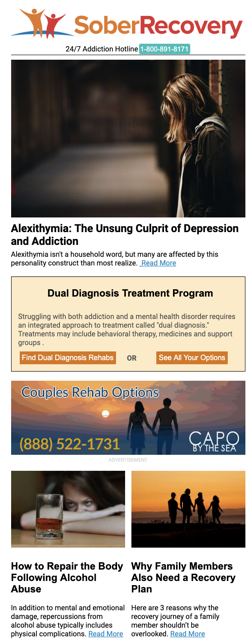Deadly Effects of Anorexia Olean NY
Olean, NY
Substance abuse
Types of Care
Outpatient
Special Programs/Groups
Adolescents, Persons with co-occurring mental and substance abuse disorders, Women

(814) 642-9522
Services Provided
Substance abuse
Types of Care
Outpatient
Special Programs/Groups
DUI/DWI offenders

Substance abuse
Types of Care
Outpatient
Special Programs/Groups
Adolescents, Women, Men

Saugerties, NY
Substance abuse , Halfway house
Types of Care
Residential long-term treatment (more than 30 days)

Substance abuse
Types of Care
Outpatient
Special Programs/Groups
Women, Men, DUI/DWI offenders

Substance abuse , Halfway house, Buprenorphine Services
Types of Care
Residential long-term treatment (more than 30 days)

Substance abuse , Detoxification
Types of Care
Hospital inpatient, Outpatient
Special Programs/Groups
Persons with co-occurring mental and substance abuse disorders, Men

Port Allegany, PA
(814) 642-9522
Services Provided
Substance abuse
Types of Care
Outpatient
Special Programs/Groups
DUI/DWI offenders

Newark, NY
Substance abuse , Detoxification
Types of Care
Residential short-term treatment (30 days or less), Residential long-term treatment (more than 30 days)
Special Programs/Groups
Persons with co-occurring mental and substance abuse disorders, Women, Residential beds for clients' children
Language Services
ASL or other assistance for hearing impaired

Hampton Bays, NY
Substance abuse
Types of Care
Outpatient
Special Programs/Groups
DUI/DWI offenders


Deadly Effects of Anorexia
In the modern world with fashion industry’s standards of beauty eating disorders are still on a balanced rise. “You can never be too thin” peer demands and daily magazine covers with ultra-thin models or stars make us only too conscious of our own flaws. What is not shown are the statistics: 20% of people with anorexia will end up dead. Anorexia nervosa, like most eating disorders, usually starts during puberty, but it can also affect adults and children. Recent studies indicate that the age of onset of anorexia is getting younger and younger, starting as early as 7 years of age. Though most commonly associated with teenage girls and adult women, it is estimated that 10% of reported cases of anorexia are boys and adult men. These numbers could be false, since anorexia is pegged as a “female disorder” and men might have difficulties admitting to the disease.People who have anorexia are obsessed with being thin and will usually go to any lengths to achieve and maintain this. They can’t see themselves through others’ eyes and often perceive themselves as fat. As a result, they will literally starve themselves in the name of “beauty”. Obsession with calorie counting, taking laxatives and diet pills or diuretics (drugs that elevate the amount of urine excretion), sometimes bulimia (inducing vomiting after a meal) and excessive exercising are the most common signs of this disease; as is hiding food or lying about food consumption. F...
Click here to read the rest of this article from Sober Recovery
Featured Facilities
Choosing the right treatment center can be paramount in one’s chance at recovery. While the treatment facility creates a foundation of tools needed for recovery, it is truly the individual, and not the addiction treatment center that determines the end result. When it comes to yourself or a loved one, you are going to want to make sure to choose a facility that has professional accreditations. Located in the Atlanta, Georgia area, Southeast Addiction Center ensures each client receives the tools needed to live a life without addictive substances.From individual therapy to group therapy, to trauma-based therapy and 12-step support, our clients learn how to find their own strength as well as create a support system around them. The transition from addiction to sobriety can be hard, however, at our drug and alcohol rehabilitation program, we guide each client through the process – step by step.
Lake Ariel Recovery Center, like all of the Sanctuary Health Group facilities, is a medically proven recovery facility that provides comprehensive treatment for substance use and co-occurring disorders. Sanctuary Health utilizes Everlasting Recovery, an approach that aligns our client’s recovery journey directly with their life, to extend recovery into a client’s lifestyle. Our unique approach establishes treatment as a daily practice, refocuses an individual away from addiction towards a healthier existence, and makes sustainable recovery achievable. Due to this integration, each client begins Everlasting Recovery by assessing their performance in various aspects of their lives via the bio, psycho, and social model. This initial assessment allows our therapists to craft a personal recovery program, which allows the greatest opportunity for our clients to suppress addiction and adopt recovery as a permanent identity. When attending Lake Ariel Recovery Center, our clients will establish life skills, implement daily routines for lifestyle recovery, and ignite a purpose for achieving better their lives. Through accomplishing these tasks, our clients will achieve sustainable recovery.
Addiction is a disease that no one should have to deal with alone. It is imperative that citizens of a city or county have access to top quality addiction treatment services. People from all walks of life can be susceptible to developing a substance use disorder in response to trauma they have endured, or lifestyle circumstances begetting maladaptive coping mechanisms.When a person is in the grips of addiction, they can become isolated and unable to see their condition for what it is—an illness that can be managed.Whether you are in Nashville or in the greater Nashville area such as Brentwood, Franklin, Hendersonville, etc, at Southeast Addiction, our outpatient addiction treatment programs offer something for individuals of all levels of commitment.
Compassionate care for individuals with opioid and alcohol use disorders. Substance use disorders are a leading cause of death, incarceration, hospitalizations, motor vehicle crashes, and numerous medical complications such as hepatitis C and HIV. We are passionate about recovery, and strive to help each patient achieve their own recovery from substance use disorders is a lifelong journey which begins with education, medical optimization, and accountability.We are proud to serve Texas as the Top Houston Suboxone Doctor and the surrounding areas with In-Office and Virtual Visit Appointments! He provides Concierge-level compassionate care for individuals with Opioid and Alcohol Use Disorders and believes treatment for addiction works to help individuals maintain long-term abstinence and recovery.With Dr. Giannotti, appointments are zero-wait, always on time as he specializes in services and treatments such as:- Anxiety treatment- Depression treatment- Insomnia treatment- Medication Assisted Treatment (MAT)Sometimes the smallest step in the right direction ends up being the biggest step in one's life. Tip Toe if you must, but Dr. Giannotti is here to take the step beside you.




